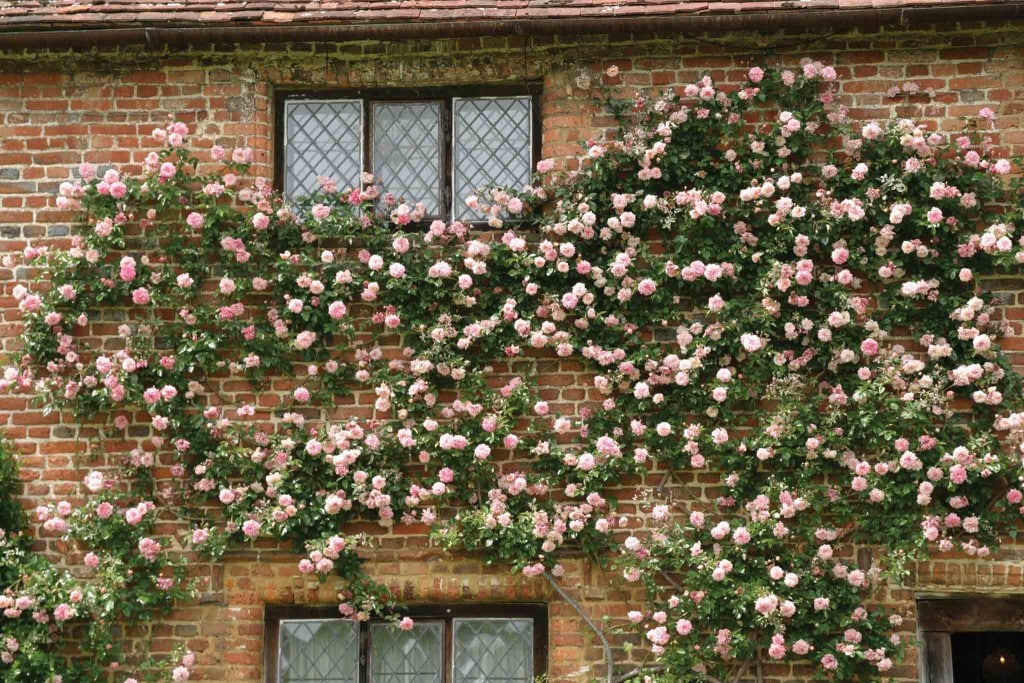Kent-based garden and landscape designer Victoria Truman www.victoriatruman.com offers her advice and tips for making the most of your plot
A good rose garden consists of many elements, each with its own part to play in creating that feeling of drama, excitement and completeness. The scent, colour and sheer variety of roses makes them a fantastic flower with so many varieties to choose from and more than one choice for every location and situation. Climbers, ramblers, shrub, tea and standard are just a few of the different species you can enhance your external space with.
A fantastic garden to visit now with so many beautiful roses about to burst into life is Sissinghurst Castle, once the home of Vita Sackville West.
Go there in the next couple of weeks and you will see for yourself just how well the gardeners have pruned and trained the roses. I always like to stand back and admire the beautiful, intricate webs of rose stems, with green and copper leaves just emerging but not yet too full to hide their design.
This specific rose training technique originated at Cliveden last century courtesy of the Astors’ head gardener Jack Vass, who took the technique with him when he moved to Sissinghurst in 1939 and they have been grown in this exceptional way ever since.
Sissinghurst’s owner, Vita Sackville-West, couldn’t have been happier when Vass arrived as she loved her roses too, particularly the dark, rich Gallicas varieties such as ‘Charles de Mills’, ‘Tuscany Superb’ and ‘Cardinal de Richelieu’.
Other National Trust properties now send their gardeners there to learn this ingenious technique.
The philosophy can be summed up as ‘treat them mean, keep them keen’. If you put every stem of a rose plant under pressure, bending and stressing it, the rose will flower more prolifically. The plant’s biochemistry tells the bush it’s on the way out and so needs to make as many flowers as possible. I’ll reveal more on the Sissinghurst technique in the pruning season later in the year.
Roses are seldom better displayed than when looking down at us from above, so climbing roses are the amongst the most valuable of all garden roses. They are perfectly suited to growing over arches and on pillars, trellises, pergolas, pillars and obelisks. Nearly all climbers have the advantage of repeat-flowering, providing colour and interest all summer long.
Roses have been valued for centuries for their fragrance. The Romans used to scent bathrooms with them and Cleopatra allegedly filled a room over a foot deep with rose petals while wooing Marc Anthony.
In general, roses with the best scents are darker and have lots of thick, velvety petals. Red and pink roses usually smell like a ‘classic rose’ all sweet and powdery while white and yellow ones often infuse tones of violets, nasturtium, and lemon. Orange roses can have fruity notes of violet, nasturtium or clove.
Roses look beautiful in amongst herbaceous borders, acting as a complimentary flowering shrub to perennials such as delphiniums. This plant combination is typical of the quintessential English cottage garden look.
Personally I love roses when they are used in a border with box balls and a clipped short yew hedge to allow for structure when the roses are over and pruned in the winter months. But whatever your individual taste or style is, one thing is for sure, any type of rose will instantly give your garden a fabulous flourish…

Top tips for ravishing roses
1. Like other plant diseases, the prevalence of rose blackspot, mildew and rust will vary from year to year, depending on weather conditions and the severity of the winter. If you haven’t fed your roses this year, do it now because vigorously growing roses are less likely to succumb to disease attack.
2. Ideally, feed your roses twice; once in March or April and again during July using a speci? c rose fertiliser such as J. Arthur Bower’s rose food.
3. It’s also worth maintaining a thick mulch over the soil surface to make sure the roses do not suffer stress due to lack of water.
4. Fastidiously clearing fallen leaves during the autumn will help prevent any disease spores from overwintering.
5. Hard pruning in early spring will remove diseased stems before the new growth starts. Mulching after pruning is also worthwhile because this will help prevent fungal spores that have overwintered in the soil from being splashed on to emerging foliage during heavy downpours in April and May.








